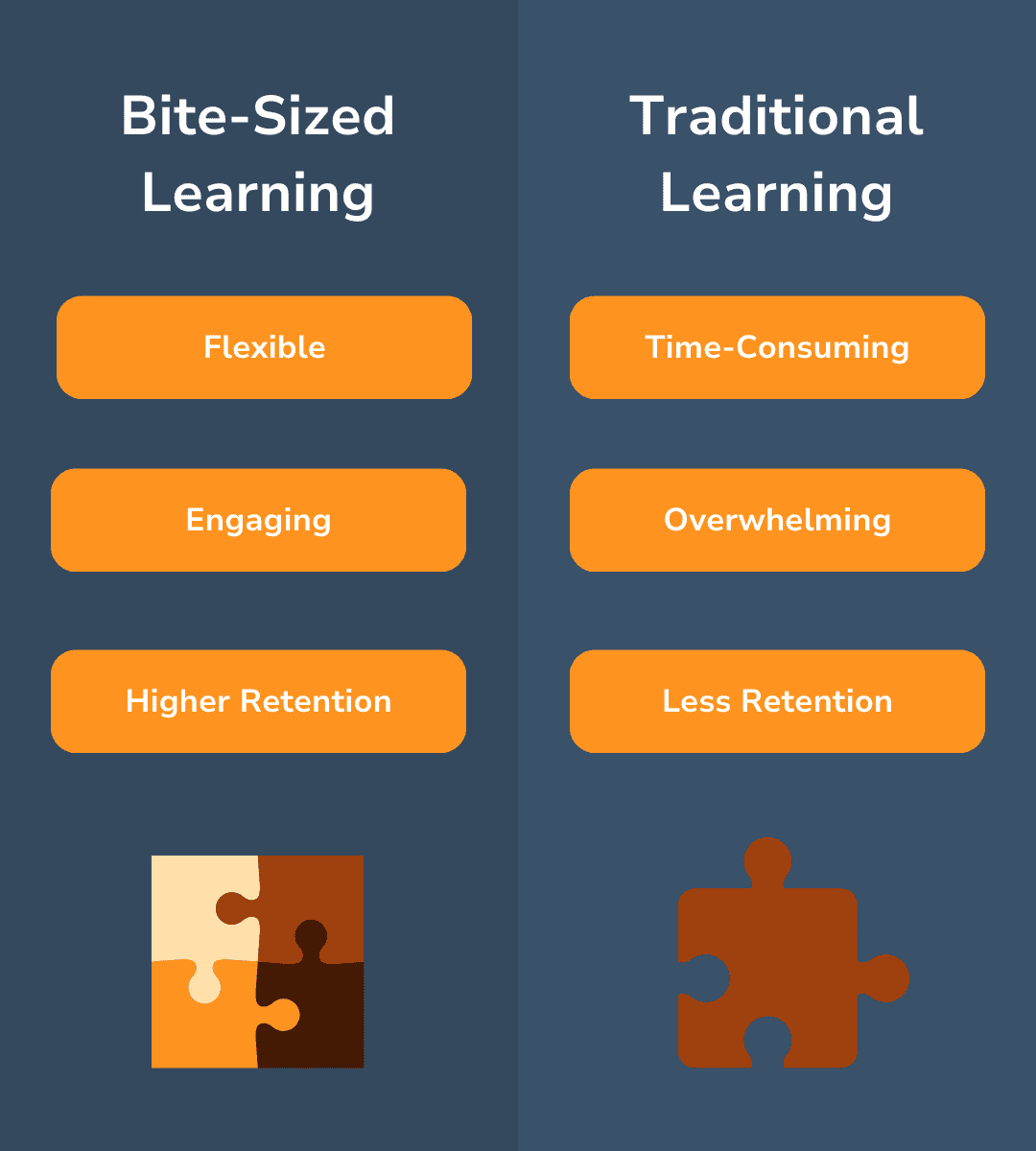
In today’s fast-paced world, the traditional approach to learning often feels overwhelming. This has led to the rise of bite-sized learning, a method that delivers information in small, manageable chunks. But what is bite-sized learning, and how can it benefit you? In this guide, we will explore bite-sized learning in-depth and discuss how FrontCore’s LMS can enhance your learning experience.
What is bite-sized learning?
Bite-sized learning, also known as microlearning, involves breaking down complex information into smaller, easily digestible pieces. This approach is popular when working with different Learning Management Systems, as it allows learners to absorb and retain information more effectively. Instead of sitting through lengthy training sessions, learners engage with concise, focused content that can be completed in minutes.

Benefits of bite-sized learning
Enhanced retention and recollection
Research indicates that learners retain information more effectively when it is presented in smaller, manageable chunks. Traditional learning methods often overwhelm learners with large volumes of information, leading to cognitive overload and reduced retention. Bite-sized learning combats this by focusing on one concept at a time, ensuring that learners can fully grasp and remember the material.
Increased engagement
By revisiting concepts through spaced repetition, bite-sized learning strengthens memory retention. Each small piece of content reinforces the previous ones, creating a solid foundation of knowledge. This approach is supported by cognitive science, which shows that our brains are wired to retain information better when it’s reviewed multiple times over spaced intervals.
Additionally, bite-sized learning often incorporates micro-assessments and practical applications immediately after presenting new information. This allows learners to apply what they’ve learned right away, further reinforcing retention and recall. The immediate application helps cement knowledge in the learner’s mind, making it more likely to be remembered and utilised effectively.
Flexibility and convenience
A significant advantage of bite-sized learning is its flexibility. Learners can access content at their convenience, fitting learning sessions into a busy schedule as smaller modules often are designed to be completed quickly and easily. A perfect way to leverage the extra minutes during a lunch break or while commuting!
Personalization
Bite-sized learning allows for a more personalised learning experience. Learners can focus on specific areas where they need improvement and skip content they are already familiar with or feel like they master. This tailored approach makes learning more efficient and relevant to the individual’s needs.
Self-paced learning
When working with smaller chunks of content, it’s easy to get a clear picture of the amount of time the learner can realistically spend learning. They can progress through the bite-sized modules at their own pace, taking the time they need to fully understand each concept.
Did you know?
In the 1880s Hermann Ebbinghaus, a German psychologist, pioneered the study of the human memory that uncovered:
- Humans forget approximately 50% of newly learned information within one day.
- The rate of forgetting is initially rapid, then gradually slows down.
- Information that is not reviewed or applied is more likely to be forgotten.
Source: The Physics Academy
Does bite-sized learning cost more than a traditional approach?
Microlearning can actually, oftentimes, be more affordable than traditional training methods! It reduces the need for expensive resources, such as printed materials, travel expenses for in-person training, and dedicated training facilities. By delivering content digitally, organisations can significantly cut down on the costs of bigger upskilling-events. The bite-sized learning approach has evolved in sync with the digital age, and this learning method is very scalable for digital platforms. If you’re looking for a solution that offers learning content that easily can be scaled to accommodate a large number of learners without incurring additional costs, bite-sized learning is a good strategy. Once the content is created, it can be distributed to an unlimited audience, making it a cost-effective solution for organisations of all sizes.
Practical examples of bite-sized learning
To illustrate how bite-sized learning can be implemented as a part of a learning strategy, we’ll explore some practical examples
1. Video Tutorials
Short, focused video tutorials on specific topics can provide quick insights and practical knowledge. For instance, a 5-minute video on effective email communication can offer valuable tips that can be immediately applied!
2. Interactive Quizzes
Interactive quizzes are a great way to reinforce learning and keep the learner engaged. After completing a module, a short quiz can help learners test their understanding and retention of the material.
3. Infographics
Infographics present complex information in a visually appealing and easy-to-understand format. They can quickly convey key points and help learners grasp important concepts at a glance.
4. Micro-Assignments
Micro-assignments involve short tasks that learners can complete in a few minutes. These assignments can reinforce learning and provide practical application of the concepts covered.
5. Flashcards
Digital flashcards are an excellent tool for memorising facts, terms, and definitions. They can be reviewed quickly and repeatedly, aiding in long-term retention.
Interested in more tips? Read our article about the benefits of online learning.
Join the Future of Training Management
Implementing bite-sized learning with FrontCore
Now that we’ve explored the benefits and examples of bite-sized learning, let’s discuss how to implement this approach using FrontCore’s LMS. To effectively implement bite-sized learning with FrontCore you can start by breaking down content into small, digestible modules, each centred around a single concept for easier retention. Incorporate diverse formats, like videos, quizzes, and infographics, to cater to different learning preferences and ensure a rich, well-rounded experience. You can also explore FrontCore’s analytics tools to track learner progress, gather feedback, and refine your approach. This data-driven strategy allows for ongoing adjustments to content and delivery methods, ensuring the learning experience remains impactful, relevant, and continuously improves over time.
Did you like this article? Don't forget to share it:






0 Comments